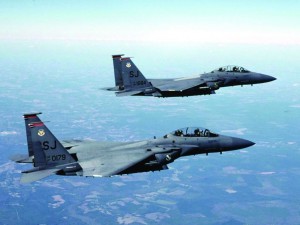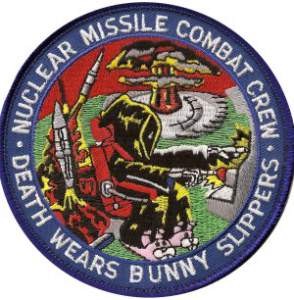On the eve of the NPT Review Conference, which began this week at UN headquarters, the NYT published an op-ed, titled “How to Avert a Nuclear War” with the intention of both setting the tone for the discussions as well as “batting around” a number of ideas and proposals designed to help the US acquire a unilateral advantage in the nuclear matchup. The article contained a number of proposals from two retired generals, one American and one Russian, on ways to encourage both Washington and Moscow to eliminate one component of their nuclear strategies – namely, “launch-on-warning (LOW).” In the United States this is understood to mean a retaliatory strike against an enemy who has acted first and already launched nuclear missiles against the US, after obtaining verification of such an attack from American ground radar stations and space-based early-warning systems, but before any “enemy” ICBMs and SLBMs that are in flight have managed to explode inside the United States.
First of all, this pitch is not new. There was a time when a group of Western experts suggested discarding this strategy and taking a look at another, ‘launch under attack (LUA)”, which allows for a nuclear strike in reprisal against a probable enemy, but only after at least one nuclear warhead has actually exploded in the US. In light of the preparations for the conference, this initiative was apparently designed to demonstrate some “flexibility” in Washington’s strategic planning for the use of its nuclear weapons.

Second, as described in the New York Times, this proposal from those two retired officers, both of whom worked with nuclear weapons during their service in their countries’ armed forces, seems odd, because after adopting the LOW policy back in 1979, Washington then proactively abandoned it 18 years later. Even the Encyclopaedia Britannica mentions that. This can also be seen in the updated Nuclear Weapons Employment Strategy released by President Barack Obama on June 19, 2013, which directed the Pentagon to examine and reduce the role of LUA in contingency planning, recognizing that the potential for a surprise, disarming nuclear attack has been significantly reduced. It feels like this article in the New York Times is being used to try to palm off on the Russians something that is really only in America’s best national interests, offering “in return” something that Washington has already long been doing unilaterally.
Third, based on the proposal put forward by the two former generals, it seems that although the US is retaining the use of nuclear weapons in initial “preemptive” and “preventive” strikes as a primary postulate of its own nuclear doctrine, the United States would like to see Russia officially renounce the idea of any potential retaliatory attack on America.
But how can you work through one strategic problem, if so many other related puzzles remain unsolved?
Washington, for example, still has no proper grasp of another dilemma associated with nuclear weapons: how to prevent collisions between Russian and American ballistic-missile and attack submarines, which are located underwater. For several decades the Soviets and then the Russians have repeatedly raised this issue with the Pentagon, but with no hope of success. This is still an immediate problem because American submarines venture too close to the Russian coast. Nor do the Americans want to be told to withdraw their tactical nuclear weapons and missile-defense systems from Europe, all of which were fused into a single consolidated attack force after the NATO summit in Chicago in May 2012.
 The Pentagon still continues its 24/7, year-round NATO air patrols over the skies of Latvia, Lithuania, and Estonia under the code name, Baltic Air Policing, using “dual-capable” aircraft that can carry either conventional or nuclear weapons.
The Pentagon still continues its 24/7, year-round NATO air patrols over the skies of Latvia, Lithuania, and Estonia under the code name, Baltic Air Policing, using “dual-capable” aircraft that can carry either conventional or nuclear weapons.
Onward. The two generals’ proposal raises a big question – the two sides are entreated to “refrain from conducting military exercises that involve practicing missile launches based on information from early warning systems.” But it is impossible to imagine that Washington, which intends to fully reequip its traditional, strategic nuclear triad and then update it by the end of this century, will suddenly agree to adopt this idea, because that would make it impossible to conduct a practical test of all the elements and programs of its ICBMs and SLBMs, or to determine how accurately they can hit hypothetical targets.
I can’t ignore the assurances by the two generals, made with an eye toward an uncertain future, suggesting that perhaps detailed measures for verifying the implementation of the bilateral agreement to abolish the LOW strategy can come later, “once better Russian-American relations are restored.” But when would that happen, if the White House, which pushed that relationship into a tailspin, makes no effort to repair it and continues to compare Russia to the grave dangers posed by Ebola and the terrorist “Islamic State”?
In this context, the two authors’ idea of negotiations on a “phased reduction of the combat readiness of the strategic nuclear forces” seems naive, when one of those two states, namely the US, has positioned an impressive array of nuclear missiles, plus antiballistic and conventional weapons, in a single operational and strategic stockpile right on the Russian border, although the Russians maintain no such combined arsenals next door to the continental United States.
As a rationale for their project, the two retired officers point to the protracted crisis in Ukraine, which was initiated and is still actively supported by a White House that is sympathetic to the leaders in Kiev, encouraging them both in word as well as in deed: by assigning military instructors to the Ukrainian armed forces and supplying them with various types of armaments, including lethal weapons.

In support of their idea, the two authors also make reference to the fact that Russia’s SPRN missile warning system is “compromised” and supposedly could be sent a false signal about a nuclear attack, due to computer glitches or errors committed by the duty officers at the nuclear launch control centers. Both of these former high-ranking soldiers suggest that Russian and US leaders get together as soon as possible to discuss doing away with the LOW strategy. Otherwise, they say, something could happen that could not be undone, such as if the two early warning systems were to transmit fallacious information to the national nuclear launch control centers, seeming to show ICBMs and SLBMs headed in each other’s direction.
But as far as Russia’s strategic nuclear forces are concerned – they are very unlikely to make such a “mistake.” As he stated in a recent interview with the journal Natsionalnaya Oborona (link in Russian), Major General Andrei Burbin, the chief of the Strategic Missile Forces Central Command, claims that those troops place a high priority on ensuring that their activities are thoroughly safeguarded against any sort of force majeure or other unforeseen events. He declares that matter has now been “100%” resolved in our country. But this is a problem that the Americans really need to work on – because this is still an issue for them, even after a special Pentagon commission identified manifold deficiencies in the proficiency tests taken by officers on alert duty at the launch control centers for America’s strategic nuclear weapons.
This is why the proposal to scrap the LOW strategy is unlikely to be accepted by the Russians. Some American nuclear-weapons experts have made a keen observation: Washington could easily follow through on an initiative to officially renounce this strategic policy on its own, unilaterally, because it does not require verification or the expenditure of significant resources or the elimination of the US doctrine of offensive nuclear deterrence. In addition, it is within the mandate of the US president, and thus could be signed by him even without the consent of Congress.
But is there any other way to avoid the accidental or unintentional use of nuclear weapons in the world? Of course there is. Why don’t the two largest nuclear powers on the globe embrace a more radical proposal – one that Moscow has repeatedly suggested to Washington, starting back in the Soviet days and continuing in the form of overtures from the Russian leaders – which is the idea to refrain from the use of nuclear weapons in a first strike or even to refuse to use them at all against each other? Would it not add to the strategic stability of the entire planet, if all of the five “legal” nuclear powers (the nuclear “club”), as well as the “unofficial” nuclear-weapon states that are not party to the NPT, followed in the footsteps of Russia and the US?
Unfortunately, the many years that have passed without action on this initiative have shown that America’s military and political leaders still resolutely refuse to implement this simple, straightforward idea to which many nations of the world subscribe.















Iran must develop a nuclear deterrent as it’s surrounded by several nuclear powers, such as, Israel, Russia, China, India, Pakistan, and 90 NATO’s nuclear bombs in Turkey. In addition, there are 17 hostile American military and naval bases threatening Iran’s rising influence in the Middle East – thus threatening Israel’s nuclear monopoly in the region.
While Barack Obama and other European leaders on Jewish Lobby’s payroll, want to make sure Iran doesn’t challenge the Zionist entity over nuclear arsenal – the US itself conducted 67 nuclear and hydrogen bomb tests in Marshall Islands since 1946.
Let’s not forget, Washington refuses to give Diego Garcia back to its native people. The country was seized and cleansed of its native people by the US and Britain – later turned into a US torture camp and a military base to control Arab people hostile to the Zionist entity like Houthis in Yemen.
http://rehmat1.com/2015/05/02/marshall-islands-lobby-cries-wolf/
A remark to Rehmat: Thank you for your comment. You are right when you mentioned a number on nuclear-weapon states whose nuclear arsenals should be taken into account while addressing the overall situation in the Middle East area. It is correct, if someone is seeking to prevent Iran from producing a N-bomb. But the same way Israel should be demanded to give up its existing nuclear capabilities as well as Turkey that has the US free-fall air-launhced nuclear weapons on its soil. Otherwise, there will not be a genuine zone in the MidEast free from nuclear and other mass destruction weapons (chemical and biological). Unfortunately, too many nations are unjustifiably putting a strong preassure upon Iran, but not upon Israel and Turkey. This disparity has been removed from the the ME WMD WFZ treaty which draft can be found in:
http://orientalreview.su/2014/11/24/time-to-establish-wmd-free-zone-in-the-middle-east-draft-treaty/.
The problem with the US nuclear weapons in Turkey is that it can be used as the first nuclear strike capability – in a preventive and preemptive strikes everywhere in the world, including the MidEast (Russia’s updated nuclear doctrines of 2014 and 2010 stipulate that its nuclear capability can be used in a second strike – only if the country is attacked).
As to Diego Garcia island in the Indian Ocean illegally seized by the UK from local people and later on leased to the USA for military purposes – it has been used several times as a bridgehead for the US forces during regional conflicts in the MidEast and the Persian Gulf. Of special concern is the fact that the airfield there can be used and de facto was used by the US heavy strategic bombers equipped by ALCMs, and as a transit air terminal to deliver the US personell from Guam to the MidEast/Persian Gulf and Europe. This island should be returned to its original inhabitants without any delay and with the relevant financial compensation.
Kind regards, Vladimir
Its very simple. Get the US to stop its defence shield.
Then and only will there be some trust by Russia and China about the
US nuclear intention.
The US cannot go round attacking China and Russia with nw and expect to be immune . Japan was defenceless when the ab was dropped.
Both Russia and China will make 100% sure the US will be unable to win
any war and suffer catastrophic destruction if they use nw on these two countries.